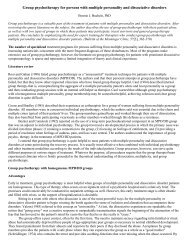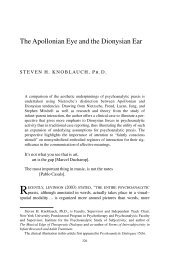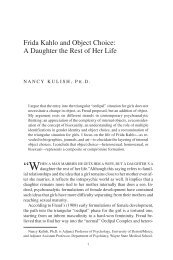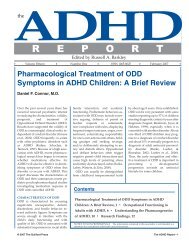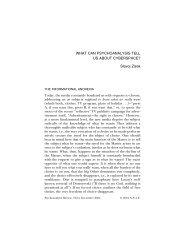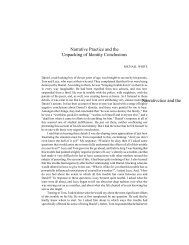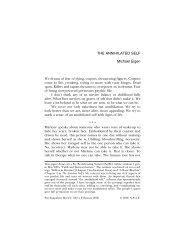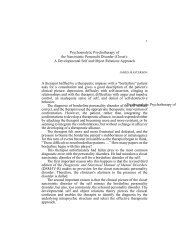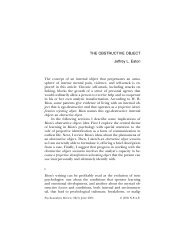What's a Good Object to Do? - PsyBC
What's a Good Object to Do? - PsyBC
What's a Good Object to Do? - PsyBC
Create successful ePaper yourself
Turn your PDF publications into a flip-book with our unique Google optimized e-Paper software.
What’s a <strong>Good</strong> <strong>Object</strong> <strong>to</strong> <strong>Do</strong> 7<br />
⎯⎯⎯⎯⎯⎯⎯⎯⎯⎯⎯⎯⎯⎯⎯⎯⎯⎯⎯⎯⎯⎯⎯⎯⎯⎯⎯⎯⎯⎯⎯⎯⎯⎯⎯⎯⎯⎯⎯⎯⎯⎯⎯⎯<br />
(Fairbairn, 1952; Kohut, 1984), loving (Fairbairn, 1952; Winnicott,<br />
1965; Klein, 1975a, b), whole, integrated self or other (Klein, 1975a;<br />
Kohut, 1984) who has acknowledged and accepted the goodness and<br />
badness in oneself and others. It occupies either internal or external<br />
space (Klein, 1975a, b; Kohut, 1984). This is an object who does not<br />
deny the existence of our more grandiose, idealistic strivings, which<br />
pull us with endless hope through life (Winnicott, 1965; Kohut, 1984).<br />
Nor does it deny our ever-present sinister affects or destructive<br />
motivations (Klein, 1975a). It has managed <strong>to</strong> accept their<br />
inevitability, <strong>to</strong> struggle with the tensions they evoke; <strong>to</strong> adapt <strong>to</strong><br />
them, integrate them, and continue <strong>to</strong> be able <strong>to</strong> love and accept love<br />
(Fairbairn, 1952; Winnicott, 1965; Klein, 1975a, b; Kohut, 1984).<br />
Again, a good object is not a perfect object, one that Klein (1975a,<br />
b) referred <strong>to</strong> as idealized and Fairbairn (1952) referred <strong>to</strong> as exciting.<br />
An idealized or exciting object, when <strong>to</strong>o pervasive or rigid, is<br />
ultimately a bad object. It represents neither a loving, a whole, nor an<br />
integrated object. Instead, it is a one-dimensional fiction, sometimes<br />
engaged with for survival, that denies the existence of complexity,<br />
ambivalence, or doubt. 3 The achievement and acceptance of doubt,<br />
which is a lifetime struggle of good objects, is an anathema <strong>to</strong> bad<br />
objects. Bad objects require immutable truths, truths that demand<br />
absolute adherence in order <strong>to</strong> survive. All doubt must be destroyed.<br />
If any uncertainty is entertained, the absolute truth and meaning of a<br />
bad object is in mortal jeopardy. For meaning <strong>to</strong> be maintained by bad<br />
objects, anything smacking of ambivalence, uncertainty, or doubt must<br />
be defended against, if not wiped out. In psychoanalysis we refer <strong>to</strong><br />
this process as the deployment of primitive defense mechanisms, such<br />
as splitting, projection, introjection or denial. For Klein (1975b), the<br />
obliteration of doubt was the hallmark of a paranoid-schizoid<br />
organization. For Fairbairn (1952), overwhelming doubt lay at the very<br />
heart of our universally split egos. For Osama bin Laden, death <strong>to</strong> the<br />
infidels obliterates those who might suggest the existence of doubt.<br />
In his seminal paper on technique and published nearly a halfcentury<br />
after Freud and a half-century before now, Fairbairn (1958)<br />
demonstrated far-reaching clinical insight:<br />
⎯⎯⎯⎯⎯⎯⎯⎯⎯<br />
3<br />
This use of “doubt” receives a more thorough explanation in an article by Sullivan<br />
(2001). The article was written in defense of the argument that we are currently<br />
engaged in a modern holy war.



